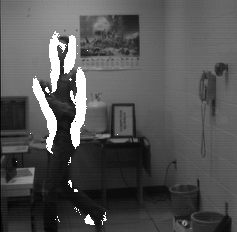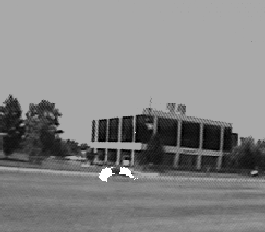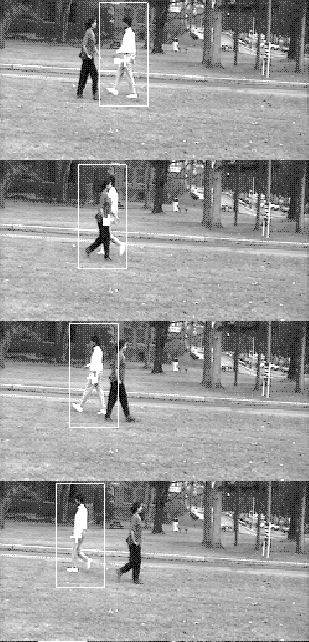Motion Detection and Recognition Research
Randal C. Nelsonand Ramprasad PolanaDepartment of Computer Science
University of Rochester


In this project we investigated two complementary methods for the detection of moving objects by a moving observer. The first is based on the fact that, in a rigid environment, the projected velocity at any point in the image is constrained to lie on a 1-D locus in velocity space, known as the constraint ray whose parameters depend only on the observer motion. If the observer motion is known, an independently moving object can, in principle, be detected because its projected velocity is unlikely to fall on this locus. We show how this principle can be adapted to use partial information about the motion field and observer motion that can be rapidly computed from real image sequences. The second method utilizes the fact that the apparent motion of a fixed point due to smooth observer motion changes slowly, while the apparent motion of many moving objects such as animals or maneuvering vehicles may change rapidly. The motion field at a given time can thus be used to place constraints on the future motion field which, if violated, indicate the presence of an autonomously maneuvering object. In both cases, the qualitative nature of the constraints allows the methods to be used with the inexact motion information typically available from real image sequences. We have produced Implementations of the methods that run in real time on a parallel pipelined image processing system. The pictures show two examples of the real-time system in operation. In the first, the camera is mounted on a robot platform that is moving vertically with respect to the room. In the second, the camera is mounted on a vehicle that is being driven towards the road on which the detected vehicle is moving.
 In this project, we investigated the use of robustly
computable motion features can be used directly as a means of recognition.
We have designed, implemented, and
tested a general framework for detecting and recognizing both distributed
motion activity
on the basis of temporal texture, and
complexly moving, compact objects on the basis of their activity.
This recognition approach contrasts with the reconstructive
approach that has typified most prior work on motion.
The motivation is the observation that in many instances,
it is easier to detect and identify objects when they are moving than when
they are stationary.
Specifically, in the case of temporal texture, the investigators extracted
statistical spatial and temporal features from approximations to
the motion field and use techniques analogous to those developed for
gray-scale texture analysis to classify regional activities such
as windblown trees, ripples on water, or chaotic fluid flow, that are
characterized by complex, non-rigid motion.
For action identification, we used an independent motion detector
to locate and track moving objects, and then used the spatial and temporal
arrangement of motion features in conjunction with Fourier
image analysis to flag and identify any objects that moved peridically.
This approach was able
to identify complexly moving objects such as machinery
and locomoting people and animals.
The picture shows an example of the tracking system following
an independently moving object in the presence of clutter and occlusion.
The tracked frame was then passed to the recognition system which
identified it as a walking person (out of 8 possibilities, which included
running and skiing people, and animal motions).
The work has practical applications in monitoring and
surveillance, and as a component of a sophisticated visual system.
In this project, we investigated the use of robustly
computable motion features can be used directly as a means of recognition.
We have designed, implemented, and
tested a general framework for detecting and recognizing both distributed
motion activity
on the basis of temporal texture, and
complexly moving, compact objects on the basis of their activity.
This recognition approach contrasts with the reconstructive
approach that has typified most prior work on motion.
The motivation is the observation that in many instances,
it is easier to detect and identify objects when they are moving than when
they are stationary.
Specifically, in the case of temporal texture, the investigators extracted
statistical spatial and temporal features from approximations to
the motion field and use techniques analogous to those developed for
gray-scale texture analysis to classify regional activities such
as windblown trees, ripples on water, or chaotic fluid flow, that are
characterized by complex, non-rigid motion.
For action identification, we used an independent motion detector
to locate and track moving objects, and then used the spatial and temporal
arrangement of motion features in conjunction with Fourier
image analysis to flag and identify any objects that moved peridically.
This approach was able
to identify complexly moving objects such as machinery
and locomoting people and animals.
The picture shows an example of the tracking system following
an independently moving object in the presence of clutter and occlusion.
The tracked frame was then passed to the recognition system which
identified it as a walking person (out of 8 possibilities, which included
running and skiing people, and animal motions).
The work has practical applications in monitoring and
surveillance, and as a component of a sophisticated visual system.
Randal C. Nelson, ``Qualitative detection of Motion by a Moving Observer'', University of Rochester Department of Computer Science TR 341, April, 1990. Abstract
Randal C. Nelson, ``Qualitative Detection of Motion by a Moving Observer'', Proc. IEEE Conference on Computer Vision and Pattern Recognition, Maui Hawaii, June 1991, 173-178. Abstract
Randal C. Nelson, ``Qualitative detection of Motion by a Moving Observer'', International Journal of Computer Vision, Vol. 7, 1, November 1991, 33-46. Abstract
Randal C. Nelson and Ramprasad Polana, ``Qualitative Recognition of Motion Using Temporal Texture'', Proc. DARPA Image Understanding Workshop, San Diego, CA, Jan 1992, 555-559. Abstract
Ramprasad Polana and Randal C. Nelson, ``Recognition of Motion from Temporal Texture'', Proc. IEEE Conference on Computer Vision and Pattern Recognition, Champaign, Illinois, June 1992, 129-134. Abstract
Randal C. Nelson and Ramprasad Polana, ``Qualitative Recognition of Motion Using Temporal Texture'', CVGIP Image Understanding, Vol. 56, 1, July 1992, 78-89. Abstract
Ramprasad Polana and Randal C. Nelson, ``Detecting Activities'', Proc. Darpa Image Understanding Workshop, Washington DC, April 1993, 569-573. Abstract
Ramprasad Polana and Randal C. Nelson, ``Detecting Activities'', Proc. IEEE Conference on Computer Vision and Pattern Recognition, New York, NY, June 1993, 2-7. Abstract
Ramprasad Polana, and Randal C. Nelson, ``Detecting Activities'', Journal of Visual Communication and Image Representation, June 1994. Abstract
Ramprasad Polana and Randal C. Nelson, ``Recognition of Activities'', Proc. International Conference on Pattern Recognition, Jerusulem, Israel, October 1994, A815-820. Abstract
Ramprasad Polana and Randal C. Nelson ``Low Level Recognition of Human Motion (or How to Get Your Man without Finding his Body Parts)'' IEEE Computer Society Workshop on Motion of Nonrigid and Articulate Objects, Austin, TX, October 1994. Abstract
Ramprasad Polana and Randal C. Nelson, ``Recognition of Nonrigid Motion'', Proceedings DARPA Image Understanding Workshop, Monterey CA, Nov, 1994, 1219-1224. Abstract
Ramprasad Polana, ``Temporal Texture and Activity Recognition'', Thesis and University of Rochester, Department of Computer Science TR 525, October 1994. gzipped postscript
Ramprasad Polana, and Randal C. Nelson, ``Non-Parametric Recognition of Non-rigid Motion'', University of Rochester, Department of Computer Science TR 575, March 1995. Abstract, gzipped postscript
Ramprasad Polana, and Randal C. Nelson, ``Detection and Recognition of Periodic, Non-rigid Motion'', International Journal of Computer Vision, To appear. Abstract